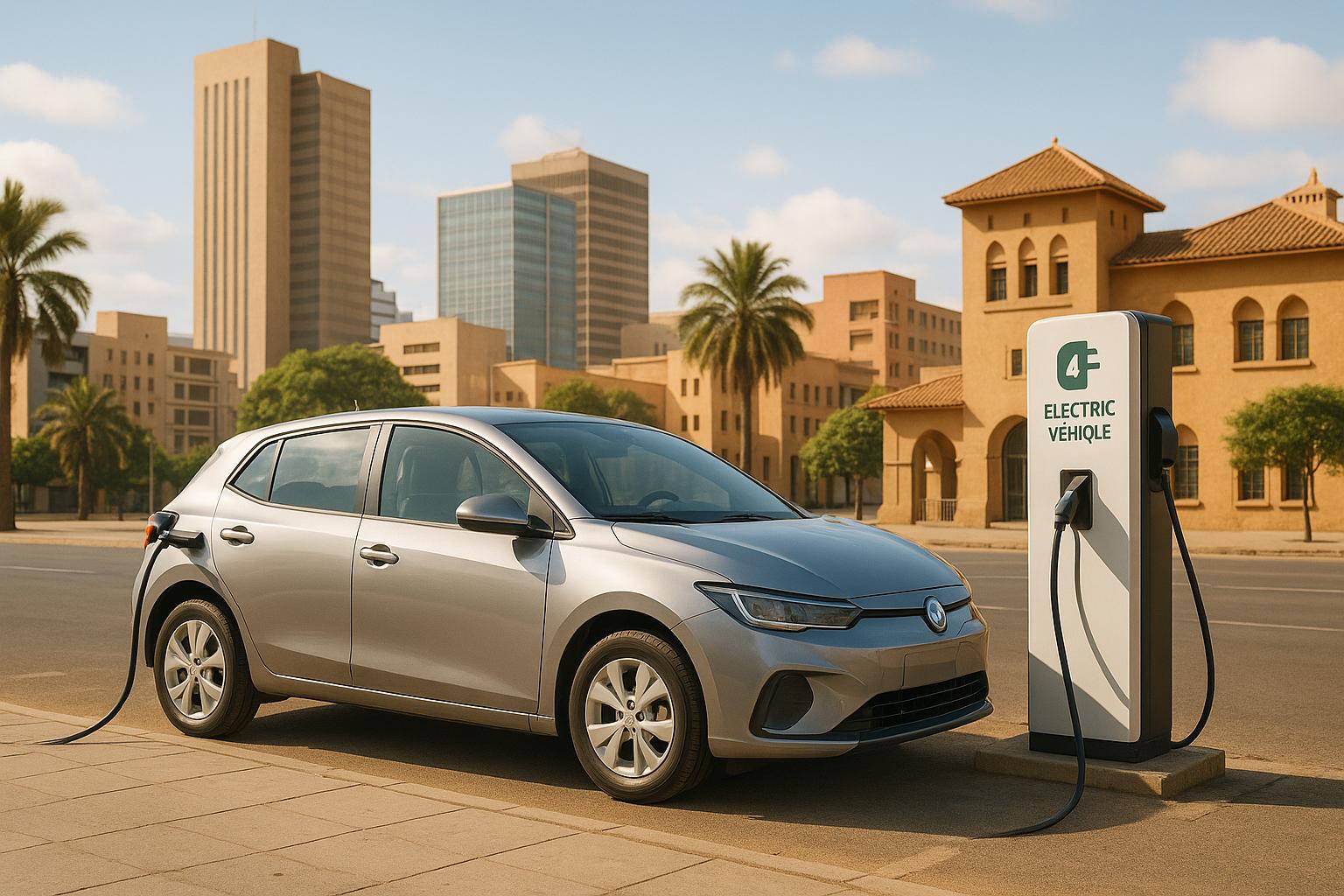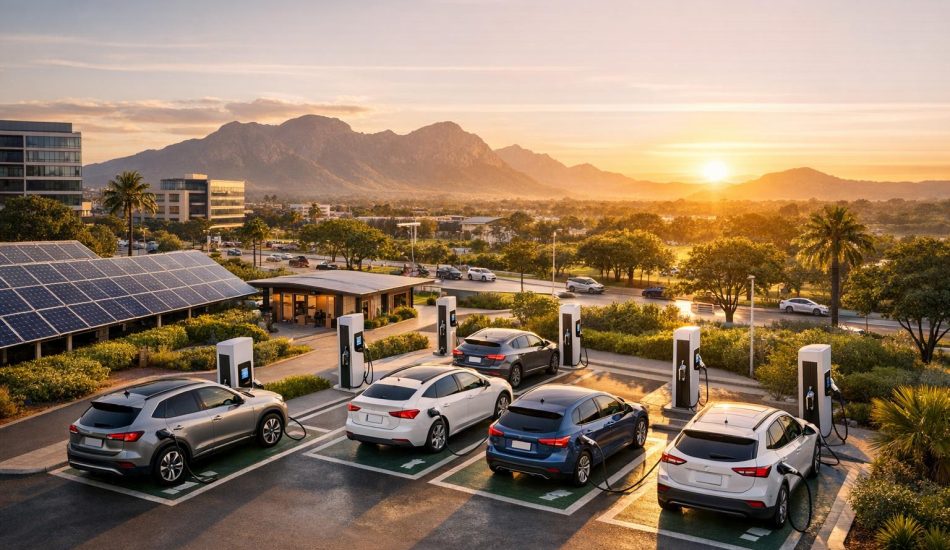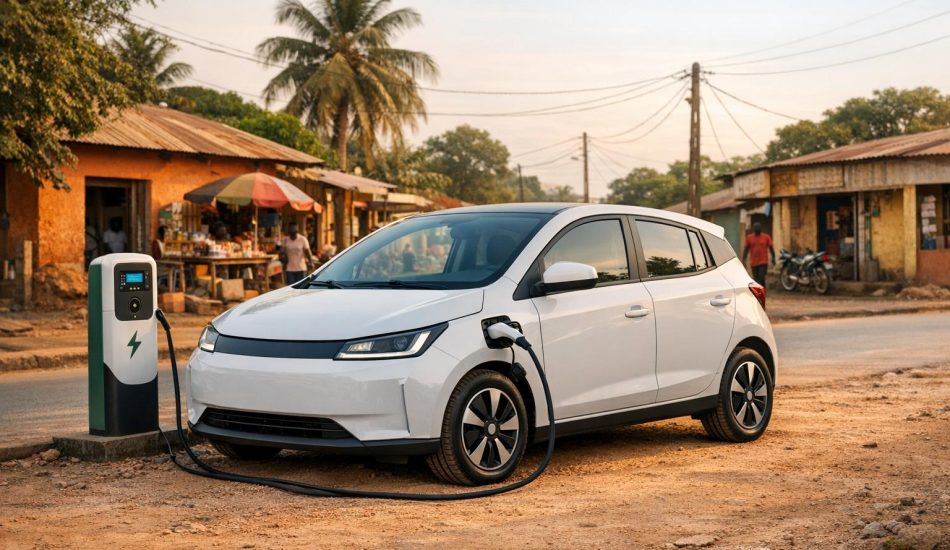
Africa’s electric vehicle (EV) market in 2025 is evolving fast, driven by local manufacturing, government policies, and better infrastructure. Here’s what you need to know:
- Local production is reducing costs by avoiding import tariffs and using Africa’s rich resources like cobalt and platinum.
- Government incentives (tax breaks, rebates) are making EVs more affordable for buyers and encouraging investments.
- Battery advancements and regional supply chains are lowering production costs, with some EVs now priced under $15,000.
- Regional differences: South Africa leads in options but faces high import tariffs; Kenya and Nigeria struggle with import dependence; Egypt benefits from growing local production.
Online platforms like EV24.africa simplify the buying process with transparent pricing, financing options, and delivery to all 54 African countries. EV prices start as low as $5,880 for entry-level models and go up to $85,000 for luxury options.
In short, Africa’s EV market is becoming more accessible, with lower prices, better infrastructure, and more options for buyers across the continent.
This African EV Charges in 30 Minutes – Here’s Why It Matters!
Main Factors That Affect EV Prices in Africa
Electric vehicle (EV) prices in Africa are shaped by a mix of factors, from production processes to government policies. These elements combine to create noticeable price differences across regions and vehicle models, influencing affordability for consumers and businesses alike. Below, we explore the key drivers behind these pricing dynamics.
Local Manufacturing and Parts Sourcing
Producing EVs locally can significantly cut costs by sidestepping hefty import tariffs. For instance, in South Africa, imported EVs are subject to a 25% tariff, compared to just 18% for traditional internal combustion engine vehicles. In some cases, the effective duty on imported cars can climb as high as 34%.
Local assembly not only avoids these tariffs but also allows manufacturers to design vehicles suited to Africa’s unique road conditions and climates. This approach ensures that EVs are better adapted to local needs, making them more practical for the region.
Beyond cost savings, local production fosters the growth of a broader EV ecosystem. South Africa, for example, has committed 1 billion rand (about $54.27 million) to support new energy vehicle and battery production, with the goal of attracting an additional 30 billion rand in private investments. Africa’s abundant natural resources further enhance this advantage. The continent holds 92% of the world’s platinum and 56% of its cobalt reserves. By processing these materials locally – rather than exporting them and then importing finished components – manufacturers can lower production costs and reduce exposure to currency fluctuations.
Government Policies and Subsidies
Government initiatives are pivotal in making EVs more affordable across Africa. Incentives like production rebates, tax breaks for local manufacturers, and consumer-focused perks such as cash rebates, tax credits, or reduced registration fees all contribute to a more predictable and competitive pricing landscape. These measures not only encourage EV adoption but also attract investment in local manufacturing, which helps drive prices down further.
The timing and scope of these policies have proven critical in encouraging EV uptake in various countries, creating a ripple effect that benefits both consumers and manufacturers.
Currency Changes and Import Dependency
Currency fluctuations also play a significant role in EV pricing, especially in markets heavily reliant on imports. When local currencies weaken against major currencies like the US dollar or euro, the cost of imported EVs can spike, leading to price instability. On the other hand, countries with local assembly operations experience more stable pricing since a larger portion of production costs is managed in local currency, insulating them from exchange rate volatility.
Battery Costs and Supply Chain Changes
Advancements in battery technology and investments in regional manufacturing are steadily lowering costs while improving performance. Morocco serves as a prime example, with Gotion’s gigafactory project valued at $6.5 billion and BTR’s cathode plant costing $366 million – both initiatives are helping reduce costs for local EV assemblers.
Additionally, economies of scale are coming into play. COBCO’s 70 GWh precursor facility in Morocco supports export routes across West, Central, and North Africa, which helps lower per-unit battery costs. These supply chain improvements are paving the way for more affordable EV models, including options priced under $15,000 – a trend expected to grow as local production ramps up. Moreover, regional battery production reduces reliance on long, complex supply chains, offering more stable pricing for consumers and manufacturers alike.
Regional Price Differences and Market Segments
Electric vehicle (EV) prices across Africa aren’t uniform – they reflect the unique economic conditions, infrastructure, and policies of each country.
Price Comparisons Across Major Markets
The cost of EVs can look very different depending on where you are in Africa. Some countries offer more affordable entry points, while others face challenges that drive up prices.
South Africa stands out as a leader in the continent’s EV market. With well-established dealership networks and financing options, it’s easier for consumers to access electric cars. However, high import tariffs often make these vehicles more expensive than traditional cars.
In Nigeria, prices fluctuate frequently. Currency instability and a dependence on imports mean that EV costs can shift dramatically in a short period, making it tough for consumers to plan or budget effectively.
Egypt benefits from its strategic location and a growing manufacturing base, which helps ease some of the costs associated with imports. The government’s push toward renewable energy and electric mobility has also created a more stable pricing environment. Still, for many middle-income families, EVs remain a stretch financially.
In Kenya, the focus on renewable energy creates a favorable backdrop for EV adoption. However, the lack of local assembly facilities means most EVs are imported, which adds a premium to their price tags.
These regional differences highlight how diverse the African EV market is – and set the stage for understanding how vehicle types and market segments play a role in pricing.
Market Segments by Vehicle Type
Africa’s EV market is shaping up to meet a variety of consumer needs and budgets.
Entry-level commuter EVs are a promising option for urban drivers. They’re typically more affordable and offer practical driving ranges, making them ideal for city commutes.
Mid-range family vehicles strike a balance between cost and features. These models, including sedans and compact SUVs, often come with larger interiors, better range, and upgraded technology – making them a good choice for families transitioning from gas-powered cars.
At the high end, luxury electric vehicles bring premium materials, cutting-edge tech, and top-tier performance. While this segment is still relatively small, it’s growing in wealthier regions like South Africa and parts of North Africa.
The distribution of these segments varies by country. Mature markets tend to offer a wider range of mid-range and luxury options, while emerging markets focus more on entry-level EVs.
Regional Factors That Drive Price Differences
Several factors play into the pricing of EVs across Africa:
- Import duties: High tariffs on imported vehicles often make EVs less competitive compared to traditional cars.
- Local assembly: Countries with limited local manufacturing capabilities rely heavily on imports, which increases costs.
- Consumer purchasing power: In wealthier regions, a broader selection of models is available, while price-sensitive areas tend to focus on affordable, entry-level options.
- Charging infrastructure: Areas with extensive charging networks can support higher-end vehicles with larger batteries, while regions with less infrastructure often lean toward smaller, more affordable models.
- Currency stability: Fluctuating exchange rates, especially in import-dependent countries, can cause sudden price changes that complicate the buying process.
These factors create a complex pricing landscape where the same EV model can vary widely in cost depending on the local market. For consumers, understanding these dynamics is key to navigating Africa’s evolving electric vehicle market.
sbb-itb-99e19e3
Popular Electric Vehicle Models and Their Prices
As of 2025, Africa’s electric vehicle (EV) market is brimming with options for every budget. Platforms like EV24.africa make it easier than ever to explore these choices by offering clear pricing details and comprehensive vehicle specifications. Here’s a closer look at some of the standout models available on the platform.
Top EV Models in Africa
EV24.africa showcases a range of popular EVs tailored to suit different preferences and needs. Premium options like the Tesla Model 3 cater to those seeking high performance and advanced features. For drivers looking for affordability without compromising on efficiency, BYD offers a selection of entry-level models. Additionally, Dongfeng provides budget-friendly vehicles that align with local market demands.
Pricing and Specifications
Every vehicle listing on EV24.africa includes essential details to help buyers make informed choices. These include:
- Price: Transparent pricing to match various budgets.
- Range: Information on how far the vehicle can travel on a single charge.
- Battery Capacity: Key data on energy storage and performance.
- Performance Metrics: Details on speed, acceleration, and overall capabilities.
Model Availability by Region
The availability of specific EV models can vary depending on regional import regulations and local demand. EV24.africa simplifies the process by gathering listings from across the continent. To make EVs even more accessible, the platform also offers financing options, ensuring more people can join the shift to electric mobility.
How Online Marketplaces and Financing Options Help
The growth of Africa’s electric vehicle (EV) market isn’t just about introducing new models – it’s about making these vehicles accessible and affordable for everyday consumers. Online platforms are playing a key role in breaking down the barriers that have traditionally kept EVs out of reach for many across the continent.
Role of Online Marketplaces
Online marketplaces are a game-changer for EV buyers, removing the uncertainty and hidden costs often associated with traditional dealerships. Take EV24.africa, for example. They offer upfront, all-inclusive pricing in USD, ranging from $5,880 for the GEELY PANDA MINI BASE to $85,000 for the ZEEKR 009. This transparency eliminates the hidden fees and markups that can surprise buyers at physical dealerships.
"At EV24.africa, we simplify the process of importing and buying electric vehicles in Africa. Our expertise ensures a seamless, transparent, and stress-free experience, so you can focus on driving the future of mobility."
- EV24.africa
Beyond pricing, platforms like this provide detailed information about each vehicle, including battery capacity, range, and performance. This means buyers can compare options and make educated decisions without the hassle of visiting multiple dealerships. And this clarity works hand-in-hand with flexible financing options, making the purchasing process even more accessible.
Financing and Accessibility
One of the biggest hurdles for EV adoption in Africa is cost. Internal combustion engine (ICE) vehicles in South Africa, for instance, typically cost between $10,500 and $21,000, while EVs start at $21,000 and can go up to $31,500. This price gap makes EVs less attainable for many consumers paying upfront.
To address this, online platforms are partnering with financial institutions to offer flexible payment plans. These options allow buyers to spread the cost over manageable monthly installments, making EV ownership more realistic for a broader audience. Excitingly, the market is anticipating the first passenger EV priced under $21,000 by 2025, which could further drive accessibility.
Additionally, these platforms ensure that the buying experience is complete with reliable delivery and customer support, making the process smoother for buyers.
Delivery and Customer Support
One standout feature of online platforms like EV24.africa is their ability to deliver across all 54 African countries. Buyers can choose from various shipping options, including RoRo, container shipping, port-to-port, or even door-to-door delivery. This flexibility is critical in a region where transportation infrastructure can vary significantly.
"Shop online with trust and transparency. EV24.africa delivers to your door anywhere in Africa."
- EV24.africa
But delivery is just one part of the equation. These platforms also handle the complex paperwork that comes with importing EVs, such as customs clearance, local registration, and compliance with country-specific import regulations.
For first-time buyers, customer support is a lifeline. Whether through email or WhatsApp, these platforms provide guidance on everything from choosing the right model to understanding charging infrastructure and maintenance. This hands-on support ensures a smooth transition into EV ownership.
Conclusion: Affordability Outlook and Future Trends
Africa’s electric vehicle (EV) market is undergoing a dynamic shift, making EVs more accessible than ever before. By 2025, the way EVs are priced, sold, and delivered across the continent is expected to change dramatically.
Key Factors Driving EV Affordability
Several factors are working together to make EVs more affordable for African consumers. Local production is reducing reliance on imports, cutting costs significantly. Supportive government policies, such as financial incentives and tax breaks, are also helping to bring down prices. Additionally, digital sales platforms are simplifying the buying process by offering transparent, all-inclusive pricing, which eliminates hidden costs.
Advancements in battery technology and improvements in supply chain efficiency are further driving down production costs. These savings are being passed on to consumers, making EVs a more attractive option.
What Lies Ahead for Africa’s EV Market
The affordability trends we see today are setting the stage for substantial growth in the African EV market. By 2026 and beyond, continued technological progress and market development are expected to make EVs even more accessible. The introduction of lower-cost passenger EVs could open the market to more middle-class buyers, marking a major turning point.
Expanding regional manufacturing and improving charging infrastructure will play a critical role in reducing costs and increasing adoption across diverse markets. Beyond affordability, these developments will create jobs and foster technical expertise, benefiting local economies.
Technological advancements, such as better battery management systems, improved connectivity, and features tailored to Africa’s unique climate, will make EVs more practical and appealing for the region. Digital-first sales models are also expected to dominate, further reducing costs and improving the buying experience. These platforms will help reach underserved areas, extending the market’s reach and ensuring more people can access EVs.
In short, strategic policies and local innovations are reshaping Africa’s EV landscape, positioning the continent as a growing force in the global EV market.
FAQs
How does local manufacturing affect the price of electric vehicles in Africa?
Local manufacturing is a game-changer when it comes to lowering the cost of electric vehicles (EVs) across Africa. By assembling and producing EVs domestically, manufacturers can sidestep hefty import duties and taxes on both vehicles and their components. The result? EVs become far more accessible to everyday consumers.
Take South Africa, for example. The country is positioning itself as a leader in EV production by using tools like Special Economic Zones (SEZs) and offering industrial incentives to attract investments. This strategy doesn’t just cut costs – it also fuels job creation and bolsters regional supply chains. Together, these efforts are making EVs a more practical and appealing choice for African buyers.
How do government policies and incentives help make electric vehicles more affordable in Africa?
Government policies and incentives play a major role in making electric vehicles (EVs) more affordable in African countries. Strategies like tax breaks, reduced import duties, and subsidies help bring down the price tag for consumers, making EVs a more viable option. For instance, some governments are cutting or even waiving import taxes on EVs to encourage more people to make the switch.
Beyond that, policies aimed at boosting local EV production and expanding infrastructure, such as building more charging stations, can gradually reduce costs further. These efforts not only lower the financial barrier for EV adoption but also lay the groundwork for a more sustainable transportation network across the region.
How do differences in infrastructure and market conditions impact electric vehicle availability and pricing in Africa?
Regional infrastructure and market conditions heavily influence the availability and pricing of electric vehicles (EVs) in Africa. In rural areas or regions with unreliable electricity, the lack of a robust charging network poses a significant challenge. Developing such infrastructure can be expensive, slowing down EV adoption. That said, creative solutions like solar-powered charging stations and battery-swapping systems are stepping in to fill these gaps.
Government policies also play a key role in shaping the EV landscape. In countries like Kenya and Ethiopia, measures such as tax breaks, reduced import duties, and subsidies are making EVs more accessible and appealing to consumers. Coupled with efforts in local manufacturing, these initiatives are gradually improving access to EVs and addressing price differences across the continent.




